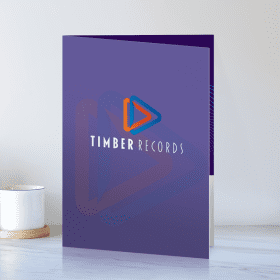Graphic Design Tips
Setting Up Artwork For Commercial Printing
The final result of your printed products, relies heavily on the quality of the artwork you submit to us. If there’s one thing we focus on here at CenTex Printing, it’s details. We know full well the importance of properly setting up artwork for commercial printing and we want to share with you some tips on how to get the best results possible. Whether you need business cards, brochures, stickers, banners, or any other printed material, we want to ensure that your final product looks professional and polished. In this article, we will provide an overview of commercial printing, discuss the software used in graphic design, explain the importance of resolution and color mode, and address the common mistakes made in artwork setup and how to avoid them.
Commercial Printing Overview
The process of commercial printing involves taking digital artwork and transferring it onto paper or other substrates. This is typically done through a process called offset printing, which uses a printing press to transfer ink onto paper. Depending on the project, different substrates may be used, such as cardstock for business cards or vinyl for banners.
The first stage of commercial printing is design, where the artwork is created using graphic design software such as Adobe Illustrator or InDesign. Once the design is finalized, it’s then prepared for printing in the prepress stage.
During the prepress stage, the design is checked for errors, and adjustments are made to ensure that the final product is of high quality. This can include color correction, font verification, and preparing the artwork for printing. The final print-ready file is then sent to the printing press.
Digital VS. Offset Printing
There are two main types of printing processes used in commercial printing: offset and digital printing.
Offset printing is a traditional printing method that involves transferring ink from a metal plate to a rubber blanket, which then presses the ink onto paper. This process is typically used for large print runs of thousands of copies or more. Offset printing provides a high-quality, consistent print result and is suitable for printing on a wide range of materials.
Digital printing, on the other hand, is a newer printing method that involves printing directly from a digital file onto paper or other materials. Digital printing is more suited for shorter print runs of a few thousand copies or less. It provides a fast turnaround time and is more cost-effective for smaller print runs. However, the print quality can be less consistent than offset printing, especially for large areas of solid color.
There are several other differences between offset and digital printing. Offset printing requires more setup time and cost, as metal plates need to be created for each color in the design. Digital printing, on the other hand, requires minimal setup time and cost as it doesn’t require plates to be created.
Offset printing is better suited for printing large quantities of high-quality printed materials, such as brochures, business cards, and magazines. Digital printing is more suited for printing smaller quantities of printed materials, such as flyers, posters, and business cards.
Software for Graphic Design
To create digital artwork, graphic designers typically use software such as Adobe Illustrator, InDesign, or CorelDRAW. These programs allow designers to create vector or raster images, add text, and manipulate colors to create the desired design. It is important to note that different programs may have different capabilities and file types, so it is essential to use the appropriate program for the project.
Importance of Resolution
Resolution refers to the number of dots or pixels per inch in an image. For commercial printing, it is important to use a resolution of 150 to 300 dpi to ensure that the printed image is clear and sharp. Using a lower resolution can result in a pixelated or blurry image, which can give a less professional appearance.
Vector Images VS. Raster Images
Vector and raster images are two types of digital images used in graphic design and commercial printing. Each type of image has its unique characteristics and best uses.
A vector image is created using mathematical equations and geometric shapes such as lines, curves, and polygons. The advantage of a vector image is that it can be resized to any scale without losing quality or clarity. This is because vector images are resolution-independent, meaning they are not made up of individual pixels like raster images. Vector images are commonly used for creating logos, illustrations, and other graphics that require scalability and precision.
On the other hand, a raster image, also known as a bitmap image, is made up of a grid of pixels, each with a specific color value. The resolution of a raster image is determined by the number of pixels per inch (ppi), with a higher ppi resulting in a higher quality image. However, if a raster image is enlarged beyond its original size, the individual pixels will become visible, resulting in a loss of quality and clarity. Raster images are commonly used for photographs and other images with complex color and tonal variations.
In terms of commercial printing, vector images are typically preferred over raster images because they can be scaled up or down without losing quality. This is particularly important for printed materials that require precision and detail, such as logos and illustrations. However, raster images can still be used in commercial printing as long as they have a high enough resolution to maintain quality at the intended print size.
RGB vs. CMYK Colors
Another important consideration when setting up artwork for commercial printing is the use of color. RGB (Red, Green, Blue) is the color palette used for digital displays, such as computer screens and televisions. CMYK (Cyan, Magenta, Yellow, Key) is the color palette used for printing.
The primary difference between the two color palettes is that RGB creates colors by adding light, while CMYK creates colors by subtracting ink. Therefore, RGB colors can appear brighter and more vibrant on digital screens, while CMYK colors are more subdued but are necessary for producing accurate and consistent colors in printed materials.
Using CMYK colors is essential for achieving accurate and consistent colors in commercial printing. When artwork is set up in RGB and then converted to CMYK for printing, the colors can appear different, resulting in an inconsistent finished product. Therefore, it is crucial to set up artwork using the CMYK color palette from the outset.
Proper Bleeds
A bleed is the area of artwork that extends beyond the finished product. This is necessary to ensure that there are no white borders or unprinted edges when the finished product is trimmed to size. Typically, a bleed of 1/8 inch is recommended to ensure that there is enough coverage for trimming. It is also important to ensure that all important elements of the artwork, such as text or logos, are within the safety margin. This is the area between the edge of the artwork and the edge of the bleed, which ensures that there is no risk of important elements being cut off during trimming.
Convert Text to Outlines
When setting up artwork for printing, it is important to convert any text to outlines. This ensures that the font is embedded in the artwork and will appear correctly even if the font is not installed on the printer’s computer. To convert text to outlines in Adobe Illustrator, select the text and go to Type > Create Outlines.
Creating a Transparent PNG
A transparent PNG file is useful when you need to place artwork over a colored or textured background. A PNG file that has been exported with decent resolution can typically be used for a wide variety of printing, including die-cut stickers. To create a transparent PNG in Adobe Illustrator, select the artwork and go to File > Export > Export As. Choose PNG as the file type and select “Transparent” under “Background Color.”
When it comes to commercial printing, properly setting up artwork is crucial for achieving high-quality results. Artwork that is not prepared correctly can result in printing errors, delays, and ultimately, a poor finished product. At CenTex Printing, we want you to be happy with the results of our work. If you don’t have experience with graphic design as it pertains to the print industry, we offer in-house graphic design and are happy to assist you. As always, if you have any questions feel free to reach out and we will be happy to help you!






















